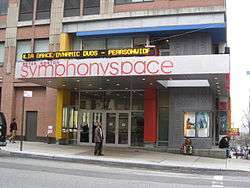Symphony Space
| Symphony Theatre | |
|
Outside view of Symphony Space in April 2008. Marquee for Leonard Nimoy Thalia is barely visible on the right edge. | |
| Address |
2537 Broadway New York City United States |
|---|---|
| Coordinates | 40°47′41″N 73°58′20″W / 40.794615°N 73.972197°WCoordinates: 40°47′41″N 73°58′20″W / 40.794615°N 73.972197°W |
| Operator | Symphony Space, Inc. |
| Capacity |
Peter Jay Sharp Theatre: 760 Leonard Nimoy Thalia: 160 |
| Construction | |
| Reopened | 1978 |
| Website | |
|
www | |
Symphony Space, founded by Isaiah Sheffer and Allan Miller, is a multi-disciplinary performing arts organization at 2537 Broadway on the Upper West Side of Manhattan. Performances take place in the 760-seat Peter Jay Sharp Theatre or the 160-seat Leonard Nimoy Thalia. Programs include music, dance, theater, film, and literary readings. In addition, Symphony Space provides literacy programs and the Curriculum Arts Project, which integrates performing arts into social studies curricula in New York City Public Schools.
Symphony Space traces its beginnings to a free marathon concert, Wall to Wall Bach, held on January 9, 1978, organized by Isaiah Sheffer and Alan Miller.[1] From 1978 to 2001, the theater hosted all of the New York productions by the New York Gilbert and Sullivan Players.
As of 2010, Symphony Space hosts 600 or more events annually, including an annual free music Wall to Wall marathon; Bloomsday on Broadway (celebrating James Joyce's Ulysses); and Selected Shorts, broadcast nationally over Public Radio International. The New York company of Revels, Inc., also holds its shows there.
Early history of the building
From 1915 to 1917, Vincent Astor spent $750,000 of his personal fortune on the Astor Market, a two-story mini-mall of stands occupying the southwest corner of 95th and Broadway. The intention was to sell fruit, meat, fish, produce, and flowers at inexpensive prices, achieved through large economies of scale. As was common with Astor's building projects, flamboyance dominated the architecture, including a 290-foot William Mackay sgraffito frieze depicting farmers bringing their goods to market.[2][3][4]
The market proved a failure. In 1917, Astor sold the market to Thomas J. Healy. The stalls were demolished and the main space was converted into the Crystal Palace, a skating rink, and the smaller basement area became the Sunken Gardens, a restaurant. Both were eventually turned into movie theaters. The rink became Symphony Theater and in 1931 the restaurant was turned into Thalia Theater.[1][5]
Symphony Theater had an undistinguished history, and by the 1970s was used for boxing and wrestling. The site was used for Wall to Wall Bach, and led Sheffer and Miller to lease the building and form Symphony Space.
Thalia Theater
The Thalia Theater was built by the experienced theater architect Raymond Irrera, and his novice assistant, Ben Schlanger. Schlanger introduced numerous innovations, including the "reverse parabolic" design for the floor.
After World War II, the Thalia gained a reputation as an arty repertory film theater. Its regular patrons included Woody Allen, Peter Bogdanovich, and Martin Scorsese.[6] Woody Allen used it in Annie Hall.
The Thalia closed in 1987, its future clouded by disputes between Symphony Space and various developers.[7] After Symphony Space won, the Thalia reopened briefly in 1993 and again in 1996. In 1999, Sheffer had the Art Deco interior gutted as unsalvageable, angering some neighborhood preservationists. The interior was used as a staging area for construction of a 22-story apartment building above Symphony Space. Afterwards the interior was rebuilt as a theater again, and in 2002 the space was re-opened as the Leonard Nimoy Thalia, acknowledging the actor's financing.[8][9]
References
- 1 2 Hofler, Robert. "new face for Space". Variety.
- ↑ "The Retailer". The Western Fruit Jobber. IV (3). July 1917.
- ↑ Gray, Christopher (Sep 10, 2006). "The Astor Legacy in Brick and Stone". The New York Times.
- ↑ Gray, Christopher (July 5, 1987). "Streetscapes: Thalia Theater; a closed revival house that may itself be revived". The New York Times.
- ↑ Not be to confused with the same named Manhattan theater that burned down in 1929.
- ↑ O'Donnell, Michelle (March 31, 2002). "Neighborhood report: Upper West Side; a revivalist revived: the Thalia returns, kindling memories in black and white". The New York Times.
- ↑ McFadden, Robert D. (May 11, 1987). "The Thalia, offbeat home of classic movies, is closed". New York Times. p. B3.
- ↑ Kilgallon, Corey (April 11, 1999). "Thalia is gutted, dismaying lovers of Art Deco". New York Times. p. CY5.
- ↑ "Leonard Nimoy Thalia at Symphony Space". Time Out New York. August 27, 2010. Retrieved February 12, 2013.
External links
| Wikimedia Commons has media related to Symphony Space. |
- Symphony Space official website
- Symphony Space on NYC ARTS
- Symphony Space on NYCkidsARTS
- Isaiah Sheffer Papers, 1891-2013 (bulk 1937-2012), held by the Billy Rose Theatre Division, New York Public Library for the Performing Arts
